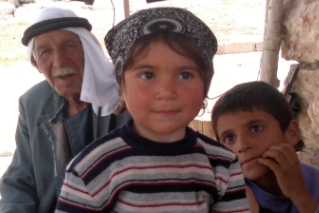 Photo by Yafit Gamilah Biso
Photo by Yafit Gamilah BisoOn Monday 14 October, the High Court of Justice will hear arguments a petition by the Association for Civil Rights in Israel (ACRI) and residents of the village of Khirbat Zanuta against the state’s plans to destroy the village of approximately 130 residents in the southern Hebron hills. In July 2012 the Court ordered the state to propose an alternative arrangement for the residents in the event their homes are demolished.
In its October 2012 response, the state ignored this order, further reinforcing the position that the village should be treated as a random assortment of structures built illegally on an archaeological site. The state further declared that it has no intention of promoting a planning solution of any kind for the village and its residents.
In December 2012, ACRI Attorney Maskit Bendel filed an addendum to the petitioners’ brief, stressing that the petition is not against the issuance of a group of demolition orders but rather the destruction of an entire village, the obliteration of a community and the deportation of its members from their homes by means of issuing demolition orders to most of these dwellings.
The addendum included an expert opinion prepared by Bimkom-Planners for Planning Rights that presents a plan for the village that would allow the residents to stay in their homes while protecting he archaeological site. An expert opinion by archeologist Dr. Avi Ofer, also included in the court documents, describes how inhabitation of the village could help preserve the historic buildings situated in the area. Additional expert opinions from a planner and preservation expert, respectively, bolster the petitioners’ argument that the state’s categorical refusal to plan the village because of the existence of an archeological site is in fact arbitrary; there are in fact plenty of examples of state-authorized plans for residential habitation near archeological sites.
Additional evidence was also presented to support the petitioners’ claims that the village has existed for decades, since well before 1967. To counter the state’s claims that the residents are new to the area, ACRI presented aerial photographs from 1989 that clearly show the existence of the village. An archaeological survey conducted by the state in 1968 further supports this fact.
According to Attorney Bendel, “Throughout the proceedings the state has maintained its claim that the village is nothing more than a smattering of structures. It has refused to see the village as more than structures or the residents as more than names on demolition orders. The Catch-22 planning and building regime enforced by the state in Area C does not allow the residents the village – or Palestinian residents in general – to build legally. We hope that the state’s position will change ahead of the hearing, that it will accept its obligation to the residents and that it will comply with the court order.”
The hearing will be presided over by Justices Edna Arbel, Yoram Danziger and Noam Sohlberg.
Additional Materials
ACRI’s information sheet on the village of Khirbat Zanuta.
Aerial photographs of the village from 1989.
The State’s response from October 2012 (in Hebrew).
ACRI’s addendum from December 2012 (in Hebrew).







